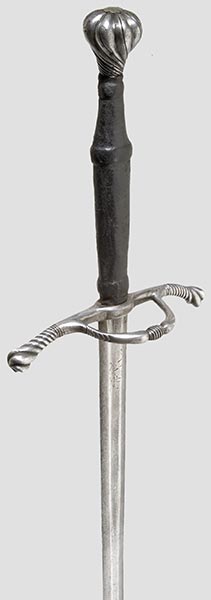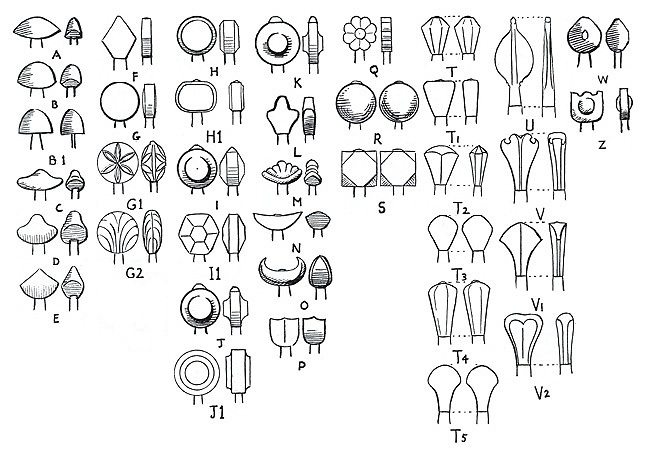Greetings,
As the title says, I am commissioning a type xviii and would appreciate your photos to help decide the design. It will also have a custom scabbard and baldric made. I have pretty much decided on the xviiib blade, and am mainly seeking ideas for the hilt. The sword will be a hand and a half sword reflecting my Scotch-Irish, and German ancestry. The photos can be from your collection, a historical example you love, one you may have seen, or even your own design. Thanks for all your help in advance. :D
Take care,
Tom
Maybe you should go to Hermann Historica - http://www.hermann-historica.com/ - and look at some of their recent auction on-line catalogues. Most of theri swords are post-Medieval, but at the top of each sword and rapier auction you will find some older swords. You might see something there that you like. The sword pictured below that I found at there site will show what kind of stuff you'll find there. Not Scots-Irish, but certainly German.
 Attachment: 9.69 KB
Attachment: 9.69 KB

German c. 1515

German c. 1515
Have you checked this out?
[ Linked Image ]
Spotlight: Oakeshott Type XVIII Swords
An article by Sean A. Flynt
[ Linked Image ]
Spotlight: Oakeshott Type XVIII Swords
An article by Sean A. Flynt
Hi,
Only two replies thus far from this esteemed forum :(
Only two replies thus far from this esteemed forum :(
I'm especially fond of the XVIIIb (see the article Chad cited and search this site for "XVIIIb").
This particular variant was popular from ca. 1480-1520. For that period you wouldn't want a baldric. Longswords typically were worn with a narrow waist belt either knotted around the upper part of the scabbard or as part of a more complex suspension that supported both the upper and middle part of the scabbard with additional straps. If using the waist belt alone the belt appears to have been worn very loosely, with the side opposite the sword resting on top of the hip bone, and the weight of the sword (hanging low on the other hip) keeping the belt in place.
This particular variant was popular from ca. 1480-1520. For that period you wouldn't want a baldric. Longswords typically were worn with a narrow waist belt either knotted around the upper part of the scabbard or as part of a more complex suspension that supported both the upper and middle part of the scabbard with additional straps. If using the waist belt alone the belt appears to have been worn very loosely, with the side opposite the sword resting on top of the hip bone, and the weight of the sword (hanging low on the other hip) keeping the belt in place.
| Tom Carson wrote: |
| Only two replies thus far from this esteemed forum :( |
There are literally hundreds of photos of Oakeshott Type XVIII swords scattered on this site and throughout the forums. This site has a lot to offer. Enjoy :)
Hi,
Thank you all for the recent replys. I have been sifting through this site for a few months now, and that enabled me to decide on the XVIIIb blade. I am primarily searching for ideas for the hilt design now. I will start sifting through the book recommendations , and put my local library staff to work :D Thanks for that!
Tom
Thank you all for the recent replys. I have been sifting through this site for a few months now, and that enabled me to decide on the XVIIIb blade. I am primarily searching for ideas for the hilt design now. I will start sifting through the book recommendations , and put my local library staff to work :D Thanks for that!
Tom
I have an idea for the hilt.
Having both Scots-Irish and German ancestors myself, I found myself interested in your project and its quest for the right hilt.
It seems to me that the Scots-Irish influence on the type XVIII would be negligible because they didn't become a people until the early 1600s when they were sent to Ireland ,whereas I think the type XVIII was more associated with the 1400s.
So, I focused on the German side. My favorite hilt for the type XVIII is the so-called "writhen" hilt, which is very German, I believe. An example of this type of hilt is to be found in the article by Sean Flynt that is referenced above. Also, Arms and Armor offer such a sword, they call it the Bohemian Broadsword, which is reviewed on this website.
Good luck with your project.
Having both Scots-Irish and German ancestors myself, I found myself interested in your project and its quest for the right hilt.
It seems to me that the Scots-Irish influence on the type XVIII would be negligible because they didn't become a people until the early 1600s when they were sent to Ireland ,whereas I think the type XVIII was more associated with the 1400s.
So, I focused on the German side. My favorite hilt for the type XVIII is the so-called "writhen" hilt, which is very German, I believe. An example of this type of hilt is to be found in the article by Sean Flynt that is referenced above. Also, Arms and Armor offer such a sword, they call it the Bohemian Broadsword, which is reviewed on this website.
Good luck with your project.
here is a copy of Oakeshott's Pommel typology. Tupe J often appears on XVIIIb's, but one of the T's or V's would also go well.
 Attachment: 97.08 KB
Attachment: 97.08 KB


Arma Bohemia does nice stock and custom work, and has a lovely XVIIIb based on an example in the Cluny museum:
http://www.armabohemia.cz/Novestr/swordsA.htm
http://www.armabohemia.cz/Novestr/swordsA.htm
Page 1 of 1
You cannot post new topics in this forumYou cannot reply to topics in this forum
You cannot edit your posts in this forum
You cannot delete your posts in this forum
You cannot vote in polls in this forum
You cannot attach files in this forum
You can download files in this forum
All contents © Copyright 2003-2006 myArmoury.com — All rights reserved
Discussion forums powered by phpBB © The phpBB Group
Switch to the Full-featured Version of the forum
Discussion forums powered by phpBB © The phpBB Group
Switch to the Full-featured Version of the forum